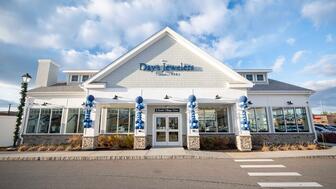Which Brands Do Watch Enthusiasts Love Most? Chrono24 Takes a Look
The watch marketplace gathered data from 1.3 million collectors, highlighting the most popular timepieces and exploring value appreciation.

The data used in the report came from the 1.3 million collectors who use Chrono24’s “Watch Collection” tool, which tracks the value trajectories of more than 3.7 million owned watches. The tool tracks value using the purchase price, whether or not the user bought the watch from Chrono24.
For the report, a “watch collector” is defined as someone who owns three or more watches, each valued above $215.
The total value of the tracked watches is $49.7 billion, or around 7 percent of the estimated $748 billion global value of all watches.
From the most-collected watches to value appreciation, here are five interesting findings from the new report.
The value of watch collections has increased by double digits, on average.
The watch collections tracked with Chrono24’s online tool increased in value by an average of 31 percent since the date of purchase in the top 20 countries.
Last year, however, saw weakened demand for certain watch brands after years of sky-high prices on the secondary market.
In 2022, collectors lost an average of 5 percent in value year-over-year. In the U.S., it was an average loss of 4 percent.
“As a general trend, the collections with higher-than-average values also saw higher-than-average value depreciation, as the top of the watch market was most affected by the downturn,” said the report.
The watch market does see volatile periods, said Chrono24, but collectors still tend to do well in the long term.
How well collectors did varied by country.
Japan and Switzerland were on the high end, seeing 40 percent growth in increased valuation.
Germany and the Netherlands were on the low end, seeing 25 and 24 percent overall growth, respectively.
The most valuable watch collections are in Asia.
In terms of median value, collectors in Thailand took the No.1 spot with the median value of their collections totaling $104,000, followed by Hong Kong ($82,500) and Japan ($68,300).
The United Arab Emirates was in the No. 4 spot ($67,700) followed by Singapore ($62,300), and Malaysia ($50,800).
The top six countries’ median values were well above the global average of $41,300.
In Europe, the most valuable collections are in Switzerland, of course, with a median value of $48,400.
The United States’ median value sits below the global average at $38,700.
These are the most popular watch brands.
The most popular brand globally on Chrono24 is, unsurprisingly, Rolex, showing up in an average of 30 to 40 percent of watch collections globally.
Omega is No.2, finding itself in nearly 10 percent of watch collections. The brand is twice as popular as Rolex sister brand Tudor, which occupies the No.3 spot.
Seiko is No.4, followed by Patek Philippe, Breitling, TAG Heuer, Audemars Piguet, IWC, and Cartier.
In the U.S., Rolex was the top choice, seen in 34 percent of collections, followed by Omega (11 percent), Tudor (5 percent), Seiko (4.9 percent), and Breitling (4 percent).
In the No. 6 spot is Patek Philippe (3.5 percent), TAG Heuer (3.3 percent), Audemars Piguet (3 percent), IWC (2 percent), and Vacheron Constantin (1 percent).
“The takeaway here is this: If you want a watch that’s easy to sell, focus on the top brands,” said the report.
“And if you want a watch that’s a little more unique, either avoid those same brands or dig a bit deeper into their archives and catalogs.”
National pride takes a back seat to brand preference.
Though one may think Americans will favor American brands while collectors in Switzerland go for Swiss watches, etc., the report found that wasn’t always the case.
Panerai, a watch brand with Italian roots, is three times more popular with Taiwanese collectors than it is with Italian ones.
Japanese brand Seiko is most popular with collectors in Finland.
Mexican collectors have twice as many watches from French brand Cartier than any other collectors, while Scandinavian collectors lean toward Omega watches.
As for high-end brands Patek Philippe and Audemars Piguet, they’re most popular in Asia, which makes sense considering collectors from Asian countries have the most expensive collections.
The top five countries for Patek Philippe are all in Asia, with Thailand (13 percent) in the No.1 spot, followed by China (11 percent),Taiwan (9 percent), Indonesia (8 percent), and Hong Kong (just under 8 percent).
Audemars Piguet is a top choice for watch collectors in China, making up 13 percent of collections. Taiwan is in the No.2 spot (7 percent).
Chrono24 noted that longevity is prized in Asian culture, and longevity is a cornerstone of the Patek Phillipe brand identity. The company’s tagline is, “You never actually own a Patek Philippe. You merely look after it for the next generation.”
There is some national brand loyalty, the report found, with Germans buying the most Nomos watches and French collectors buying the most Bell & Ross timepieces.
Switzerland, home to world-class watch brands, prizes Rolex and is also the most popular market for IWC.
The British, meanwhile, were found to favor Tudor watches more than anyone else.
Those looking for a less popular brand may want to seek out vintage TAG Heuer or Eberhard & Co. watches.
“Those brands only make up a fraction of a percentage of collections on average, despite rising popularity among collectors and auction houses,” said the report.
The future of the market is bright.
Chrono24 reached out to Dr. Brendan M. Cunningham, professor of economics and founder of watch blog Horolonomics, to add some expert insight to its report.
“Often what we see during recessions and turbulent times in the economy is a flight to those kinds of assets that have low or minimal default risk,” he said.
“One of the advantages [of watches] is that they can be a somewhat stable store of value, although you do have to be careful because, as we’ve seen, some particular references have seen corrections in their value.”
Still Cunningham shared an optimistic sentiment about the future of the watch industry.
In particular, he highlighted Rolex’s plans to build new factories to bolster production.
“I don’t think a lot of people have made a lot of money betting against Rolex and Rolex’s decisions,” he said.
“The reverse of ‘everything that goes up must go down’ is, ‘everything that goes down must go up.’ So, I do think the future is bright for watch collectors, and watches themselves, and the industry as a whole.”
For more information or to read the full report, visit the Chrono24 website.
The Latest

Set in a Tiffany & Co. necklace, it sold for $4.2 million, the highest price and price per carat paid for a Paraíba tourmaline at auction.

The jeweler’s “Deep Freeze” display showcases its iconic jewelry designs frozen in a vintage icebox.

Take luxury gifting to new heights this holiday season with the jeweler’s showstopping 12-carat sphene ring.

How Jewelers of America’s 20 Under 40 are leading to ensure a brighter future for the jewelry industry.

This year's theme is “Unveiling the Depths of the Ocean.”


In its annual report, Pinterest noted an increase in searches for brooches, heirloom jewelry, and ‘80s luxury.

Starting Jan. 1, customers can request the service for opal, peridot, and demantoid garnet.

Roseco’s 704-page catalog showcases new lab-grown diamonds, findings, tools & more—available in print or interactive digital editions.

The 111-year-old retailer celebrated the opening of its new location in Salem, New Hampshire, which is its third store in the state.

The new catalog features its most popular chains as well as new styles.

The filmmaker’s personal F.P. Journe “FFC” prototype was the star of Phillips’ recent record-setting watch auction in New York.

Inflations, tariffs, and politics—including the government shutdown—were among consumers’ top concerns last month.

“Longtime favorite” presenters, as well as first-time speakers, will lead talks and workshops at the annual event in Tucson next year.

Silas Smith of Meridian Metalworks won the challenge with his pendant that blends Australian and American landscapes.

The sale of the 31.68-carat, sunset-hued stone was part of Sotheby’s first series of events and auctions in Abu Dhabi.

Most customers who walk into your store this month have made up their minds. Your job is to validate their choice, Emmanuel Raheb writes.

The collection features characters and motifs from Ukrainian folklore, including an enchanted mirror and a magic egg.

MatrixGold 3.11, the newest version of the jewelry design program, offers more flexibility, precision, and creative control.

The pavilion will be part of the 2026 JA New York Spring show, scheduled for March 15 to 17.

Kadet, a 1994 National Jeweler Retailer Hall of Fame inductee, helped grow the family-owned retailer in the Chicago area and beyond.

Billed as the world’s smallest wearable, Lumia Health’s new smart earrings have a health tracker subtly embedded in the back.

Don’t let those with December birthdays feel blue. Help them celebrate their month with blue zircon, turquoise, and tanzanite.

The new pink sapphire version of the piece dances with its wearer in the brand’s “Icons After Dark” holiday campaign.

A choice that’s generated a lot of commentary, Pantone says “Cloud Dancer” marks a fresh start and encourages relaxation and creativity.

The manufacturer’s holiday campaign features a gift guide filled with trending designs and jewelry that can be personalized.

The man was charged with theft, accused of ingesting the necklace while in a jewelry store in Auckland, New Zealand.

The Florida independent expanded its store from 8,000 to 14,000 square feet, fulfilling the vision of its late co-founder, Jim Dunn.



























